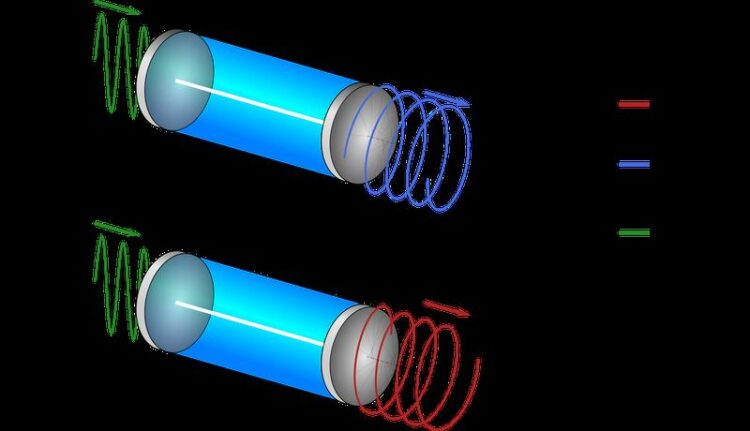The perfect trap: a new way to control the polarization of light

Illustration how the polarization in the fibre change from linear to circular.
Credit: Max Planck Institute for the Science of Light
For quantum communication or optical computing it is important to measure and to influence in which direction a light wave is oscillating. It is now for the first time possible to manipulate this polarization of a continuous laser wave with a special glass fibre, which has mirrors attached at both ends. The effect was discovered by a team of researchers from the Max Planck Institute for the Science of Light in Erlangen together with colleagues from Switzerland, the UK, and Germany. They have published their discovery in the prestigious journal Nature Communications.
The scientists are now able to change the polarization of a continuous light wave which is oscillating in one plane into a wave which oscillate in a circular way – which resembles the shape of a corkscrew. They achieve this effect by sending infrared laser light into a two metre long glass fibre made of silica. At both ends there are special mirrors, which reflect more than 99 percent of the light and are made of thin layers of tantalum pentoxide and silicon dioxide produced by the Swiss University of Neuchâtel. For comparison: A normal bathroom mirror has only a reflectivity of around 90 percent.
The light in the fibre is trapped between these nearly perfect mirrors and starts to change its behavior: above a certain threshold of optical power the polarization changes and the light polarization moves either clock- or anti-clockwise forward. The researchers are able to control the direction by changing the power of the light. “It is technically possible to miniaturize our structures and integrate them into an optical chip”, says Pascal Del’Haye, head of the Microphotonics research group at the MPL.
In the future one could arrange many of these devices onto a photonic chip in order to generate and control complex polarization states for example for telecommunication systems. In addition, these devices can also work as highly sensitive sensors and improve the performance for example of optical neural networks used in artificial intelligence applications or of systems for quantum information processing.
Wissenschaftliche Ansprechpartner:
Pascal Del’Haye
Microphotonics Research Group
pascal.delhaye@mpl.mpg.de
Originalpublikation:
https://www.nature.com/articles/s41467-021-27933-x
Weitere Informationen:
https://mpl.mpg.de/news-events/news-from-the-institute/news-detail/article/News/…
https://mpl.mpg.de/research-at-mpl/independent-research-groups/delhaye/
Media Contact
All latest news from the category: Physics and Astronomy
This area deals with the fundamental laws and building blocks of nature and how they interact, the properties and the behavior of matter, and research into space and time and their structures.
innovations-report provides in-depth reports and articles on subjects such as astrophysics, laser technologies, nuclear, quantum, particle and solid-state physics, nanotechnologies, planetary research and findings (Mars, Venus) and developments related to the Hubble Telescope.
Newest articles

Innovative 3D printed scaffolds offer new hope for bone healing
Researchers at the Institute for Bioengineering of Catalonia have developed novel 3D printed PLA-CaP scaffolds that promote blood vessel formation, ensuring better healing and regeneration of bone tissue. Bone is…

The surprising role of gut infection in Alzheimer’s disease
ASU- and Banner Alzheimer’s Institute-led study implicates link between a common virus and the disease, which travels from the gut to the brain and may be a target for antiviral…

Molecular gardening: New enzymes discovered for protein modification pruning
How deubiquitinases USP53 and USP54 cleave long polyubiquitin chains and how the former is linked to liver disease in children. Deubiquitinases (DUBs) are enzymes used by cells to trim protein…


